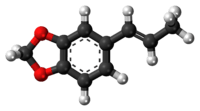Isosafrole
 trans-Isosafrole | |
 cis-Isosafrole | |
 | |
| Names | |
|---|---|
| IUPAC name
5-(Prop-1-enyl)benzo[d][1,3]dioxole | |
| Other names
5-(1-Propenyl)-1,3-benzodioxole 3,4-Methylenedioxyphenyl-1-propene | |
| Identifiers | |
| 120-58-1 4043-71-4 (trans) 17627-76-8 (cis) | |
| 3D model (Jmol) | Interactive image |
| ChEMBL | ChEMBL487603 |
| ChemSpider | 21106329 |
| ECHA InfoCard | 100.004.010 |
| |
| |
| Properties | |
| C10H10O2 | |
| Molar mass | 162.19 g·mol−1 |
| Density | 1.1206 g/cm3, trans 1.1182 g/cm3, cis |
| Melting point | 8.2 °C (46.8 °F; 281.3 K) trans -21.5 °C, cis |
| Boiling point | 253 °C (487 °F; 526 K) trans 77–79 °C, cis @ 3.5 mmHg |
| Except where otherwise noted, data are given for materials in their standard state (at 25 °C [77 °F], 100 kPa). | |
| | |
| Infobox references | |
Isosafrole is an organic compound that is used in the fragrance industry. Structurally, the molecule is related to phenylpropene, a type of aromatic organic chemical. Its fragrance is reminiscent of anise or licorice. It is found in small amounts in various essential oils, but is most commonly obtained by isomerizing the plant oil safrole. It exists as two geometric isomers, cis-isosafrole and trans-isosafrole.
Isosafrole is a precursor to the important fragrance piperonal.[2] It can also be converted via the intermediate compound MDP2P into the psychoactive drug MDMA ('ecstasy'). As such it requires permits to purchase or sell in any significant quantity in the US.
References
- ↑ Merck Index, 11th Edition, 5112
- ↑ Karl-Georg Fahlbusch, Franz-Josef Hammerschmidt, Johannes Panten, Wilhelm Pickenhagen, Dietmar Schatkowski, Kurt Bauer, Dorothea Garbe and Horst Surburg "Flavors and Fragrances" in Ullmann's Encyclopedia of Industrial Chemistry, Wiley-VCH, Weinheim, 2003. doi:10.1002/14356007.a11_141
This article is issued from Wikipedia - version of the 7/16/2015. The text is available under the Creative Commons Attribution/Share Alike but additional terms may apply for the media files.